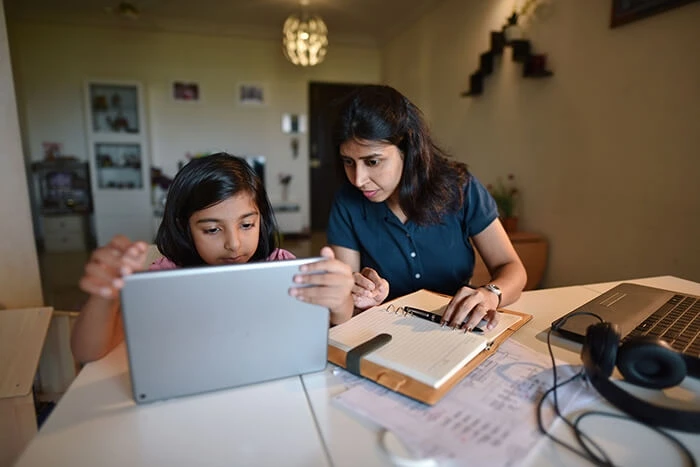& Construction

Integrated BIM tools, including Revit, AutoCAD, and Civil 3D
& Manufacturing

Professional CAD/CAM tools built on Inventor and AutoCAD
Businesses have been moving toward digital transformation for years, but that trend shifted nearly overnight in early 2020 when the COVID-19 pandemic placed a new sense of urgency on entire industries.
In the span of a few weeks, established companies were forced to pivot their workforce operations, means of business, and points of sale to make way for upended supply chains, new safety regulations, and transformed protocols. In short, it left business leaders with a lot of new demands—and a lot of new worries.
But as business leaders and creative thinkers do, most shifted rapidly. After the initial shock passed and the reality of doing business amid a pandemic set in, companies turned to their strongest assets—their workforces—to nurture business growth through resilience. This meant finding new ways to interact with customers, invite business, and keep the proverbial (or literal) doors open.
Now, as the protocols of pandemic life are becoming second nature and the reality of an effective vaccine signals better days ahead, leaders are looking toward what comes next.
In a three-part series titled “Strategies for Business Growth in the Next Normal,” Susan Etlinger, former senior analyst at Altimeter, explores the challenges leaders face regarding what business and employment look like in the near future. Etlinger interviewed dozens of experts and business leaders and conducted extensive research to get a sense of how the workplace, relationships, and business models will evolve in the coming months and years. In short, there will be no returning to “normal,” only the normal that comes next.
“This idea of ‘normal’ is a bit of a fever dream, right?” Etlinger says. “It’s a lovely kind of dream that things are going to be stable. I think that we have to find a way to live productively, happily, and creatively in uncertainty. And that idea of creative uncertainty, of using that uncertainty to test our own resilience, is really important.”
Resilience in disruptive times, Etlinger says, will be a hallmark of business growth after the pandemic—as well as a sign of readiness to thrive in the face of future disruptions.
“One thing that’s so interesting to me, and so exciting in a way, is to think about how much we’ve all learned in this last year,” Etlinger says. “Of course, it’s been hard. We’ve lost people, and it’s been challenging in ways that few could have imagined. But we’ve learned so much, and that’s precious. We should be putting that to work.”
The following four key takeaways from Etlinger’s research explain how businesses can increase resilience and growth using the hard-earned lessons of this pandemic year.
Companies spend millions of dollars every year “gaming” for natural disasters. They plan for hurricanes, tornadoes, floods. They strategize for economic downturns, power-grid failures, political changes. But few had considered the possibility of a worldwide pandemic before 2020. Even if they had, Etlinger says, it’s clear that many businesses had not considered the broader implications or how what happened beyond their doors would ultimately find its way in.
“Typically what has happened in the past is that people think about scenario planning purely from a financial perspective,” Etlinger says. “What would happen to revenue and profit if our supply chains didn’t work, we couldn’t get people into work, or our orders dried up? But it’s now clear why leaders need to look at scenario planning from a comprehensive standpoint. What would happen to our cities? What would happen to our transportation systems? What would happen to schools? What would happen to our health-care systems? What are the best, medium, and worst-case scenarios? Those types of modeling activities have been fairly exclusive in terms of who was responsible for them.”
But, Etlinger says, the rare companies that did that modeling have laid the groundwork for how other companies should think, plan, and strategize for the future.
“One finding of this report is that scenario planning needs to become a muscle that everybody uses,” she says. “It’s not a negative to think about the worst thing that can happen. It’s a way to make sure that we’re not brittle—that our organizations aren’t fragile when things happen outside of our expected horizon. Planning for unexpected events is part of how we have to make our systems more flexible, more resilient, so that if we do see things happening or indications that something is about to happen, we have plans in place to manage them effectively, rather than being caught flat-footed.”
Seemingly overnight, nearly every business sector was turned on its head. Distribution and fulfillment centers were busier than ever because people stuck at home were shopping online. Meanwhile, the travel and hospitality industries came to a screeching halt. But for businesses in sectors like construction, architecture, and engineering, conversations were flipped around: Do we need this many offices? How can we use our offices differently? What do we offer now that we couldn’t a month ago?
That, Etlinger says, is precisely the kind of thinking that helped businesses of all stripes thrive. Manufacturers of Apple iPhone cases, for example, could choose to close down or start making personal protective equipment (PPE). Those that had the option chose PPE.
But what about companies offering things that didn’t have immediate value in the crisis? That’s where companies found their creativity.
“Many asked, ‘How can we appropriately respond to this set of circumstances in a way that both captures value for the company—and that doesn’t have to immediately mean financial value—but is supportive of financial value?’” Etlinger says. “Companies needed to flip the switch from actively marketing to you as they would in a normal market. They needed to show they’re trying to be as helpful to you as they could throughout this process to support your business continuity. They certainly hoped that when things stabilized, people would continue those purchases or the services that they’ve been getting for free, leading to perhaps more preference for the company.”
Etlinger’s research isn’t a post-hoc analysis: The pandemic is not over. Through her many interviews, she has gained invaluable understanding of what companies have learned about themselves, their workforces, their customers—and their unique experiences from adapting to distributed work and other challenges.
“We don’t yet have analytics for the whole spectrum of workplaces, wherever they may be,” Etlinger says. “We don’t really have a set of signals that tells leaders what they need to know in the environment we’re working in now. Businesses have a set of tools, business intelligence, CRM, resource planning. We have all those tools that were created to function primarily in silos.”
So what good are those tools when the environment changes? The monumental task for business leaders is twofold. First is to create dashboards that better replicate the progress possible in physical spaces and translate them to digital spaces. For example, how can face-to-face meetings in the office shift to screens filled with talking heads in boxes? And how can happenstance encounters—which can produce multimillion-dollar ideas—be replicated in a digital office interface? Second, how can businesses build systems that enable the entire organization to better understand and respond to what is happening, wherever they may be?
Many companies in the past year struggled to exercise flexibility as an employer when responding to real-life employee circumstances. Etlinger says that productivity in myriad workplaces like offices, construction sites, factories, and so on does not always look the same in a distributed workplace. Employees might be parents working while overseeing their kids’ remote learning—or may be the sole caretakers of older relatives.
“You have to connect all those things together to understand what productivity means,” she says. “And then you have to ask yourself, ‘What signals am I missing? What might I be able to intuit in an office or other kind of work site that I can’t see in a distributed environment?’
“We have to think creatively about the data we have at our disposal and what signals we are missing,” Etlinger continues. “And I think that’s a hard question to ask leaders, but it’s a really important one because it can make you very vulnerable to say, as a leader, ‘I don’t know what I’m missing. I don’t know how my people are doing. They tell me they’re okay. But we’re asking them to learn a whole new language of communication.’”
Ultimately, Etlinger says, the pandemic and its resulting changes to business expectations can “allow us as leaders to craft the kinds of norms that work best for our own organizations and for the needs of our people.”
Kimberly Holland is a lifestyle writer and editor based in Birmingham, AL. When not organizing her books by color, Holland enjoys toying with new kitchen gadgets and feeding her friends all her cooking experiments.
Executive insights
Executive insights
Executive insights
Illustration by Micke Tong.








